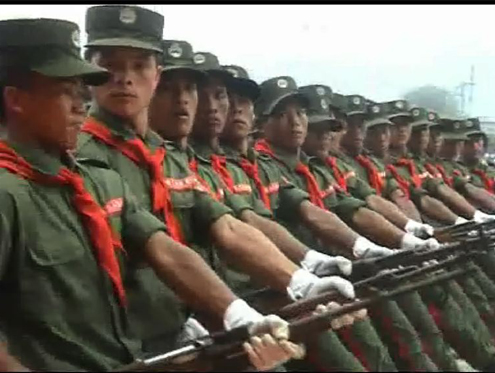The Chinese military has sent armed helicopters equipped with air-to-air missiles to Burma’s largest ethnic rebel group the United Wa State Army (UWSA), according to a report published in Jane’s Intelligence Review on Monday.
The shipment of Mil Mi-17 helicopters represents the “latest move in a programme of rapid rearmament” after the Chinese reportedly supplied the UWSA with armored vehicles and man-portable air defence systems (MANPADS) during the second half of 2012.
“My interpretation of what they’re doing is very simple. The Chinese are establishing a deterrent that will discourage any adventurism on the part of the Tatmadaw along the border,” said the reports author Anthony Davis during an interview with DVB.
Officials from the Chinese embassy in Rangoon dismissed the allegations as “impossible” when questioned by DVB, while a spokesman from the UWSA denied receiving such military hardware.
“In our group, there are a few educated people,” said UWSA spokesperson Aung Myint.
“There are no pilots who can fly the helicopter. So I would like to raise a question, why have they released this kind of report?”
However, according to Jane’s, both ethnic minority and government sources within Burma confirmed the delivery of the helicopters, which were reportedly flown over the Laos border in late February and March to the UWSA rather than directly from China.
The shipment of the helicopters comes as the Burmese military continues their offensive against the Shan State Army-North (SSA-N), who signed a ceasefire with the government in January 2012.
According to a report in the Shan Herald Agency for News, the Burmese military is currently in the process of trying to take four mountain bases on the west bank of the Salween River belonging to the rebel group in an effort to cut off and surround the UWSA.
“So when this fighting broke out [in February], it was part of a series of [maneuvers] by the Burma army to control all the areas west of the Salween… this mountain overlooks the Salween crossing that goes to the Wa territory,” said the Shan Herald’s editor Khunsai Jaiyen, during an interview with DVB in March.
“Naypyidaw, after it has laid a complete siege to the Wa territory, then could talk to the Americans, to the Western countries who are concerned about the Wa’s drugs. Only after it is assured of support – total support from the west, especially the Americans – it would launch an attack, but not right away because it would be costly.”
Much to the chagrin of Burma’s neighbours, large quantities of narcotics, particularly methamphetamines, are produced in the Wa territories, which are later trafficked into Thailand and southern China and then throughout Southeast Asia.
“The UWSA is clearly concerned at what look like preparations for aggressive action against them. So they have taken the unusual step of sending troops in to support the SSA-N, which has been countering Tatmadaw advances,” said Davis.
“The relationship between the UWSA and the SSA-N goes back to the communist period, before the founding of the UWSA, when the Wa were part of the CPB (Communist Party of Burma). So they’re not strangers to each other and clearly now their interests are very directly linked.”
Following the Tatmadaw’s massive dry-season offensive against the Kachin Independence Army (KIA) in December and January when the Burmese military used helicopter gunships and air strikes to take several key positions around the rebel stronghold Laiza, the Wa’s new hardware may serve as a valuable deterrent and discourage government forces from attacking.
According to the report in Jane’s, “The Mi-17s are armed with what appear to be Chinese TY-90 short-range air-to-air missiles. If this report is accurate, the TY-90 would provide a serious deterrent to Tatmadaw Mi-24P ‘Hind’ gunships recently acquired from Russia and already deployed in counter-insurgency operations against the Kachin Independence Army.”
However, analysts say a government offensive against the UWSA, which Jane’s regard as perhaps the largest non-state armed group in the world with more than 20,000 troops at the ready, is unlikely for the time being.
“Hypothetically speaking, if in a year’s time the Tatmadaw were to launch an offensive against the Wa, it would be a very significant war. The scale of fighting against the KIA last December and January would look like a schoolyard brawl by comparison with a full-scale conflict between the Tatmadaw and the UWSA,” said Davis.
“[The UWSA] has much greater numbers, much better trained troops and, as we’re seeing, significant hardware.”
Formed from the remains of the CPB that fractured along ethnic lines after the group imploded in the late 1980s, the Chinese have maintained strong ties with the Wa and have only further consolidated relations since officials in Naypyidaw have begun courting Western nations during the country’s nascent reform period.
“At the end of the day, if the Tatmadaw intend to go for this target, they’ll go for it,” said Davis. “And that is clearly what the Chinese have every interest in preempting and preventing.”
-Additional reporting provided by Ko Htwe



